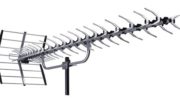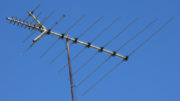If you’re new to the world of over-the-air antennas, you might feel overwhelmed by some of the terms. It’s natural. Luckily The Solid Signal Blog is here to help! Here’s a list of some of the terms you might encounter, along with some common-sense definitions.
A-B
AM: A type of frequency used for radio stations. Some over-the-air TV antennas can also pull in AM signals.
Amplifier (Booster): An amplifier is a device used in conjunction with an OTA antenna designed to help make up for signal loss due to long runs of cable or splitters.
Beam Width: Beam Width describes the range of signals an antenna can receive when pointed in a single direction. Expressed in degrees, an antenna with a larger beam width can pick up signals from further off-axis than one with a narrow beam width.
Bow-Tie: This is a design of antenna typically used for UHF only antennas and is named that because the front of the antenna usually has elements that look like a bow-tie. Typically these antennas are square, or rectangular in shape, and have a metal mesh screen on the back of them. This type of antenna is an example of a dipole, the most common type of antennas.
C
CEA Ratings: Antenna codes are broken into six different zones. These zones identify the different types of antennas that are required for a consumer to receive optimal reception. Typically, the closer consumers live to the signal tower, the better reception they will receive. CEA ratings are still valid but since they were introduced, they’ve often been ignored. Most consumers look for antenna that works in the range they need, and is shaped attractively to them.
Channels 2-6: Not to be mistaken with the channel number on your television, this actually refers to the RF frequency that is used for the Low band VHF frequencies. The RF channel frequency and the actual channel on your television will often be different from one another. This range is also called “VHF-Low.”
Channels 7-13: Not to be mistaken with the channel number on your television, this actually refers to the RF frequency that is used for the High band VHF frequencies. The RF channel frequency and the actual channel on your television will often be different from one another. This range is also called “VHF-High”
Channels 14-36: This actually refers to the broadcast RF frequency of a channel. The RF channel frequency and the actual channel on your television will often be different from one another. In the past, you could actually pick up TV channels up to channel 83 but those frequencies have been taken for other uses.
Coaxial Cable: Coaxial cable connects an OTA antenna to your television. This is the same type of cable that satellite and cable companies use. RG6 coaxial cable is the most popular type of coaxial cable for antenna use.
Combiner: A small device that allows two or more antennas to share the same wire going into the home.
D-L
dB: dB stands for decibel. A decibel is a unit of relative measurement. It describes how much more of something you have, compared to something else. In antennas, decibels measure gain.
Deep Fringe: A term used to describe an antenna that has the ability to pull in OTA stations that are very far away.
Dipole: A type of antenna where two pieces of metal sit horizontally and intercept incoming signals effectively. Almost every antenna uses this feature in one way or another.
Directional: A term used to describe an antenna that can pick up stations in the direction it is pointed at only. These types of antennas usually do not have much more than a 30-50 degree range on a compass.
FM: A type of frequency used for radio stations. Some OTA TV antennas can also pull in FM signals.
Gain: Gain is the key measurement of antennas. An antenna with more gain will work more effectively than one with less gain. Gain measurements are in decibels, or dB.
High VHF: A category of VHF frequencies that is in regards to RF channels 7-13. Also called “VHF-High.”
Low VHF: A category of VHF frequencies that is in regards to RF channels 2-6. Also called “VHF-Low”
M-P
Multi-directional: A term used to describe an antenna that can pick up channels from the direction it is pointed at. Each antenna carries a rating showing how wide a range it can receive signals from, called beam width.
Omni-directional: An omnidirectional antenna can pick up stations from any direction at the same time without having to rotate it.
OTA: Stands for “Over the Air”. In this case, this term means that an antenna can receive radio or television broadcasts. The term can also generically mean “wirelessly.”
R-Z
RF: Short for Radio Frequency. This term describes the full set of frequencies used for all broadcasting. Antennas use frequencies from 54-600MHz.
Rotator/Rotor: A device used to rotate an antenna in different directions. If your local broadcasts come from different directions, a rotator can help you get all the broadcasts you want.
Splitter: A device used to split your signal from your antenna off to multiple televisions. If you plan on splitting your antenna to multiple televisions you should also purchase an amplifier to make up for signal loss. A splitter can also be a combiner if you switch the inputs and outputs.
UHF: Stands for “Ultra High Frequency”. In TV antenna terms it represents the RF frequencies used from 14-36
UHF/VHF: An antenna labeled as UHF/VHF can receive all television frequencies.
VHF: Stands for “Very High Frequency”. In TV antenna terms it represents the RF Frequencies used from 2-13.





